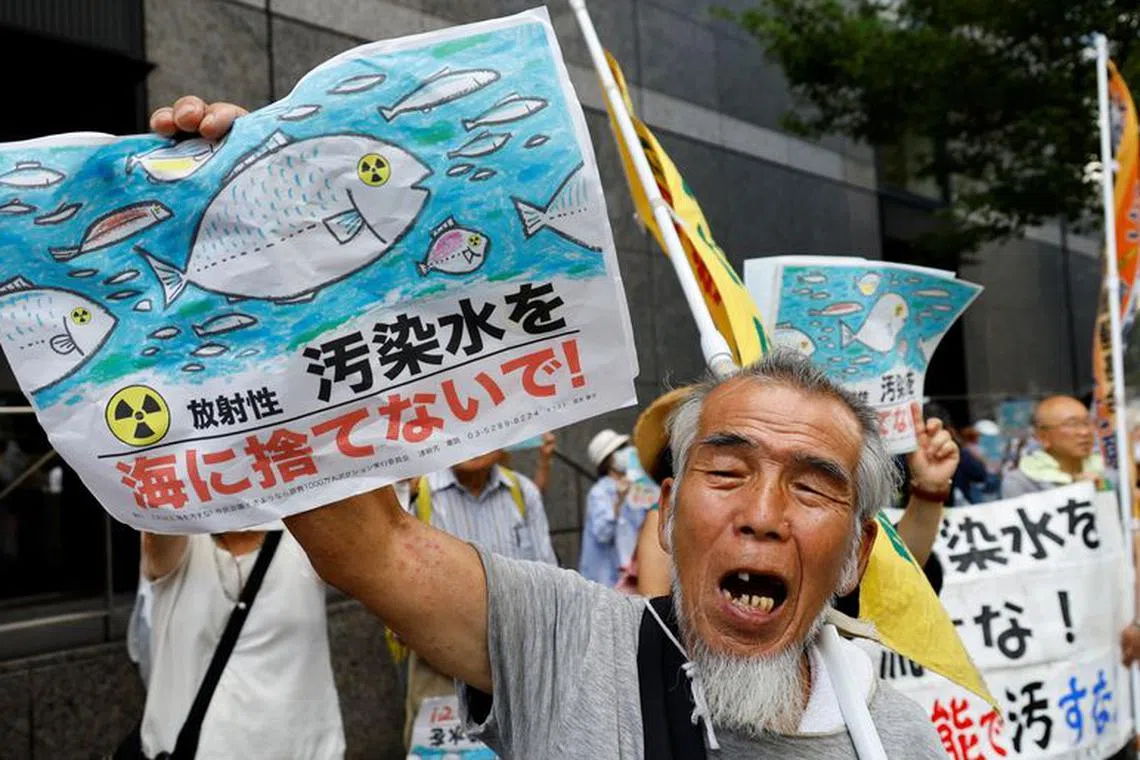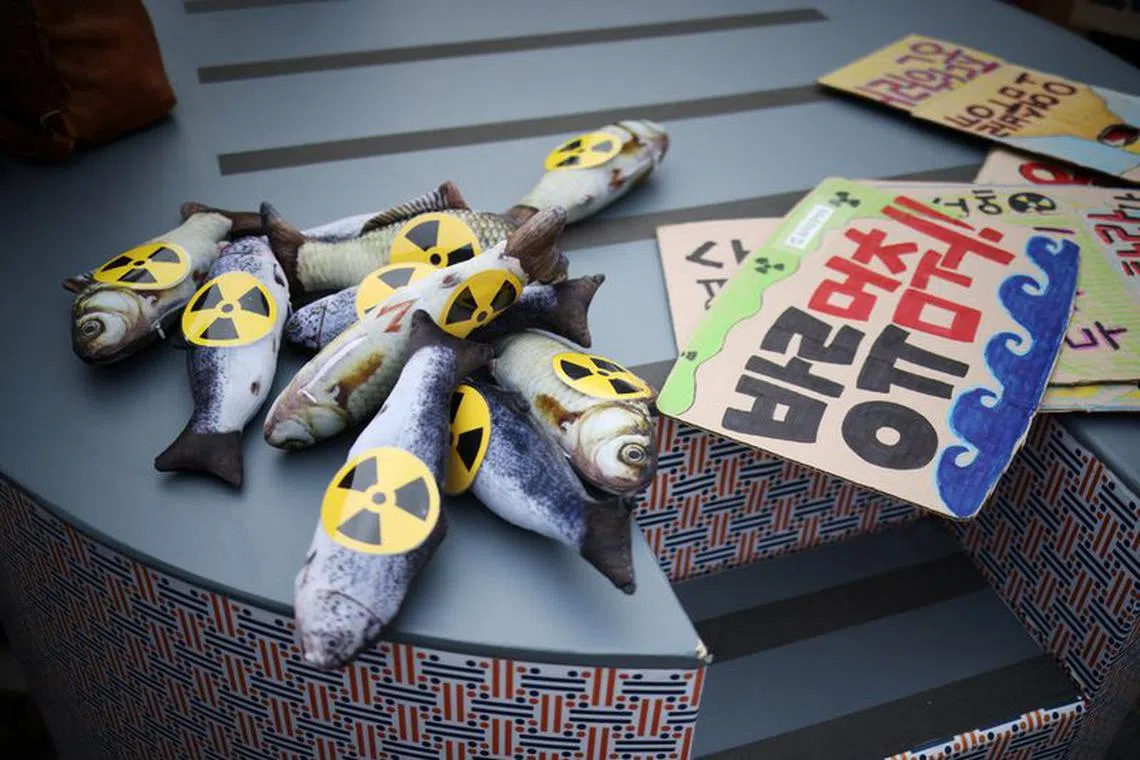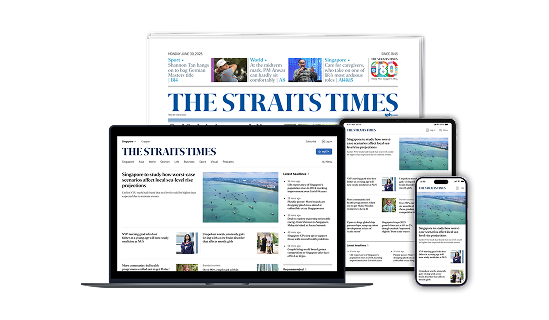Japan releases Fukushima water into the ocean, prompting criticism, seafood bans
Sign up now: Get insights on Asia's fast-moving developments

A protester holding a placard reading "No radiation contaminated water into the sea" during a rally against Japan's plan to discharge treated radioactive water into the ocean on Aug 24.
PHOTO: REUTERS
Follow topic:
TOKYO - Japan on Thursday started releasing treated water from the wrecked Fukushima nuclear power
Approved two years ago by the Japanese government and greenlit by the UN nuclear watchdog in July, the discharge is a key step in a dauntingly long and difficult process of decommissioning the Fukushima Daiichi plant, including the removal of molten fuel.
Plant operator Tokyo Electric Power Co (Tepco) said that the release began at 1.03pm local time (12.03pm Singapore time) and that it had not identified any abnormalities with the seawater pump or surrounding facilities.
Following the release of the wastewater, which was slammed by China’s foreign ministry
China’s Customs authority said it would “suspend the import of aquatic products originating in Japan from Aug 24, 2023, including edible aquatic animals”.
The decision was taken to “comprehensively prevent the food safety risks of radioactive contamination caused by the discharge of nuclear wastewater from Fukushima into the sea”, the General Administration of Customs said.
Japan has requested that China immediately lift its import ban on aquatic products
The European Union lifted its import restrictions against Fukushima produce earlier in August, reducing the number of countries and regions with import measures in place to just nine worldwide.
Among these nine regions are China and Hong Kong, which have announced stiffer import restrictions following the water discharge.
Beijing had already suspended all food imports from 10 out of 47 Japanese prefectures in July, with Hong Kong following suit.
Sales to China and Hong Kong accounted for 42 per cent of all Japanese aquatic exports in 2022, according to government data.
China imported more than US$500 million (S$676 million) worth of seafood from Japan in 2022, according to Customs data.
Several brands of salt were sold out on online food delivery sites in the coastal province of Fujian, as well as in parts of Beijing and the commercial capital of Shanghai after Japan began discharging the treated water, according to media reports.
“It’s really not necessary to hoard salt, but when I saw loads of people panic-buying this morning, I quietly ordered 10 packets,” wrote one user on microblogging platform Weibo.
“I bought lake salt and salt from salt mines. I now avoid sea salt.”
Tokyo has criticised China for spreading “scientifically unfounded claims”.
It maintains the water release is safe, noting that the International Atomic Energy Agency (IAEA) has also concluded that the impact it would have on people and the environment was “negligible”.
“IAEA experts are there on the ground to serve as the eyes of the international community and ensure that the discharge is being carried out as planned, consistent with IAEA safety standards,” IAEA director-general Rafael Grossi said.
“Through our presence, we contribute to generating the necessary confidence that the process is carried out in a safe and transparent way.”
Decades-long process
The release of the wastewater has unsettled other countries in the region, with Cook Islands Prime Minister Mark Brown saying that while science supported Japan’s decision, the region may not agree on the “complex” issue.
Japanese fishing groups, hit by years of reputational damage from radiation fears after the plant was destroyed by a tsunami, have long opposed the plan. They fear it will lead to a loss of sales, including from export restrictions to major markets.

Fish-like dolls bearing radiation warning signs are pictured during a protest against Japan’s plan to release treated wastewater on Aug 24, 2023.
PHOTO: REUTERS
The water will be released in smaller portions initially and with extra checks.
The first discharge totalling 7,800 cubic m – the equivalent of about three Olympic swimming pools of water – will take place over an estimated 17 days.
According to Tepco test results released on Thursday, that water contains up to 63 becquerels of tritium per litre, below the World Health Organisation drinking water limit of 10,000 becquerels per litre.
A becquerel is a unit of radioactivity.
Tepco expects the process of releasing the wastewater – currently totalling more than 1.3 million tonnes – to take about 30 years.
Civic groups have launched protests in Japan and South Korea.
A few dozen protesters gathered in front of Tepco’s headquarters in Tokyo holding signs reading, “Don’t throw contaminated water into the sea!”
“The Fukushima nuclear disaster is not over. This time only around 1 per cent of the water will be released,” 71-year-old Jun Iizuka, who attended the protest, said. “From now on, we will keep fighting for a long time to stop the long-term discharge of contaminated water.”
South Korea’s government has said its own assessment found no problems with the scientific and technical aspects of the release, but urged Tokyo to be transparent during the process.
“What’s important now is whether Japan, as it promised to the international community, strictly follows the scientific standards and transparently provides information,” Prime Minister Han Duck-soo told a briefing.
South Korean police arrested 16 people on Thursday for entering a building housing the Japanese embassy in Seoul, carrying off and bundling some into a bus after banners were unfurled to protest Tokyo’s release of the wastewater.
“The sea is not Japan’s trash bin,” read one of the banners hung by the group, made up mostly of young people, on the eighth floor of the building, where the embassy is located.
North Korea’s foreign ministry demanded that the water discharge be immediately halted, calling it a “crime against humanity”, state media reported.
The Fukushima Daiichi plant was destroyed in March 2011 after a massive 9.0-magnitude earthquake

